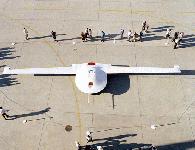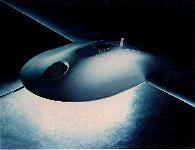- DarkStar Tier III Minus
-
- The Tier III Minus UAV, known by the
nickname DarkStar, is one of two high altitude endurance UAVs being developed
for the Defense Airborne Reconnaissance Office (DARO) by the Advanced Research
Projects Agency (ARPA) joint UAV program office. At a planned $10 million
a copy (FY94 dollars), the DarkStar UAV will provide affordable, near real
time, continuous, all weather, wide area surveillance in support of tactical
commanders. The result will be timely information that the tactical commander
can immediately exploit for accurate situational awareness and to perform
precision strikes and other high priority intelligence and reconnaissance
tasks.
-
- The DarkStar system is a high-altitude,
endurance unmanned air vehicle optimized for reconnaissance in highly defended
areas. Optimized for low observables, DarkStar's operational goal is to
be highly survivable while penetrating high threat environments. Complementing
the Tier III Minus is the Tier II Plus, which will be optimized for long
range and endurance in a low-to-moderate threat environment. Both vehicles
will be capable of fully autonomous take-off, flight and recovery; be capable
of dynamic retasking while in flight
-

-
-
- It will operate within the current military
force structure, and with existing command, control, communications, computer
and intelligence equipment. It can operate at a range of 500 nautical miles
from the launch site and will be able to loiter over the target area longer
that eight hours at an altitude of more than 45,000 feet, carrying either
an electro-optical or synthetic aperture radar sensor payload.
-
- The sensor system is similar to the Global
Hawk, except there is less bandwidth in terms of the communications links
because of the low observable installation of the antennas. In addition
DarkStar carries either the radar or the EO payload on this aircraft, whereas
Global Hawk can carry both payloads simultaneously. The radar payload has
the same capability as the Global Hawk radar, with the exception of not
having a GMTI mode. The EO system is a little bit degraded in terms of
the NIIRS it can provide, but per hour it provides the same level of area
coverage capability or the same number of spots per hour as provided with
the Global Hawk system.
-
-

-
-
- When Dark Star missions are allocated
to Army commanders, or an Army officer is the JTF commander, the Enhanced
Tactical Radar Correlator (ETRAC) and Modernized Imagery Exploitation System
(MIES) (or successor processors) will process the imagery. If the U.S.
Air Force is the "lead" Service, the processor would be the Contingency
Airborne Reconnaissance System (CARS); if the Navy and Marines go in first,
the Joint Services Imagery Processing System-Navy (JSIPS-N) would process
the imagery. The Common Ground Station (CGS) will display the imagery no
matter which system processed it.
|